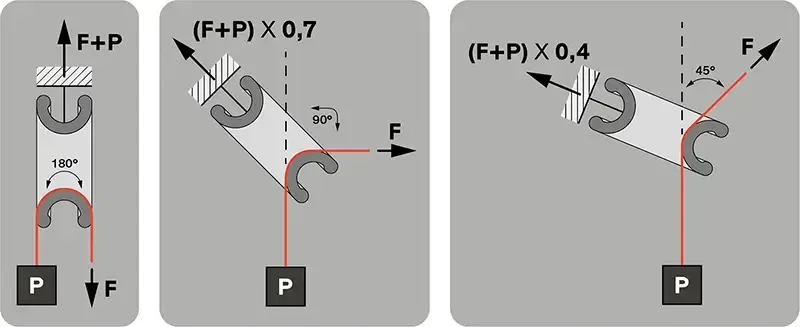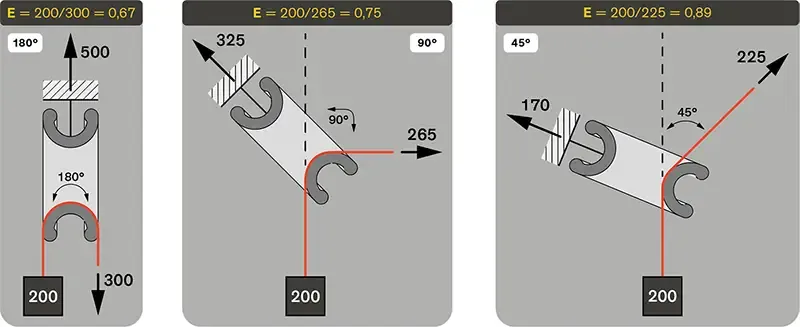 Efficiency of Low Friction Rings with different angles and lines.
Efficiency of Low Friction Rings with different angles and lines.
2.1 EFFICIENCY FOR DIFFERENT ANGLES

From experimental test on an Antal Low Friction Ring MOD. RL6.1 using a common 10 mm line with polyester cover, we have found that to lift a weight of 200 kg we have to apply a force equal to 300 kg. So we have to add 100 kg for the friction between the rope and the ring. This is the result with the maximum line deviation equal to 180° but what happens with different deviation angles? For example, for angles of 90° or 45°?
With the same line tension by decreasing the angle form 180° to 90° and to 45° the load on the ring decreases and therefore friction decreases too. With reference to the force required to lift a weight of 200 kg the following values, for different angles, result from simple calculation.

In the drawing we have also reported the efficiency values E equal to the ratio between the lifted weight (200 kg) and the applied force. For 180° deviations the efficiency E = 0,67 is very low, much better values for smaller deviations up to the excellent E = 0,89 for 45° deviations. Consider that the maximum value of efficiency (zero friction) is equal to 1.
The 90° angle is the typical case of a mast base block, the 45° angle is the case of a deck organizer. In the next section, we will see how efficiency can be further improved by using different lines.
2.2 EFFICIENCY WITH DIFFERENT LINES
We compare the efficiency E of a Low Friction Ring using a line with polyester cover (A) and a Dyneema line without cover (B).
- (A) Line with polyester cover: to lift a weight P = 200 kg, according to the diagram in the figure, it is necessary to apply a force F = 300 kg. The result is an efficiency: E = 200/300 = 0,67
- (B) Dyneema line without cover: the force F is reduced to 250 kg and the efficiency becomes: E = 200/250 = 0,80
With Low Friction Rings it is very advantageous to use Dyneema lines without cover that offer minimal friction and increase the efficiency E up to 0,80 (+20% compared to the value obtained with a common rope with polyester cover).
Note: the value of efficiency for an ideal block without friction is 1 and the best value of efficiency obtained with a roller bearing block is 0,93 (see Antal Technical Info #01). The above results were obtained with test on the Antal ring MOD RL6.1 using a 10 mm line with polyester cover and a 6 mm Dyneema line without cover. Reported results are derived from tests that depend on the size and type of the tested samples and ropes and also on the load range and therefore must be considered only indicative.

































































































































































































